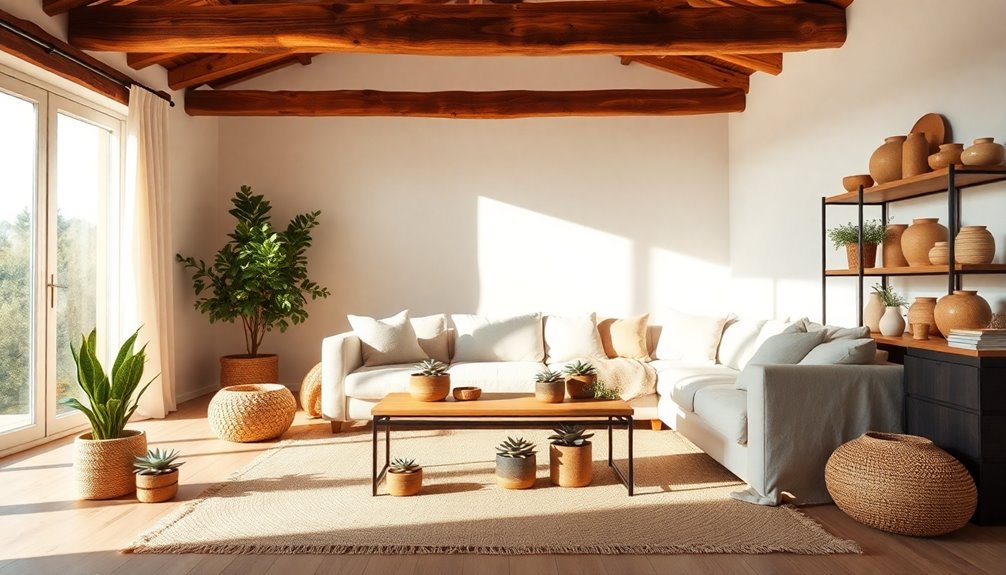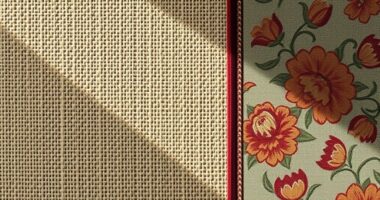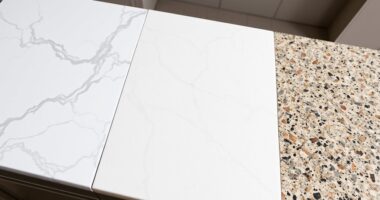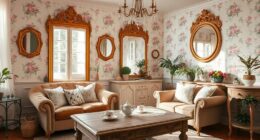For durable and attractive cabinets, your choice of material matters. Solid wood offers unique grain and a natural look but needs regular maintenance; plywood provides stability and moisture resistance at a reasonable price; MDF gives a sleek, painted finish and is cost-effective but less durable. Each has pros and cons depending on your style, budget, and long-term plans. Want to find out which material best suits your needs? Keep exploring for detailed insights.
Key Takeaways
- Solid wood offers natural beauty and durability but requires maintenance and is more prone to moisture-related issues.
- Plywood provides a stable, moisture-resistant option with a uniform appearance, balancing cost and strength.
- MDF is affordable, smooth, and ideal for painted finishes but less resistant to moisture and damage.
- For longevity and environmental sustainability, consider solid wood or eco-friendly plywood options.
- Choose based on budget, desired aesthetic, durability needs, and environmental considerations for the best cabinet material.
Comparing the Composition and Construction of Each Material
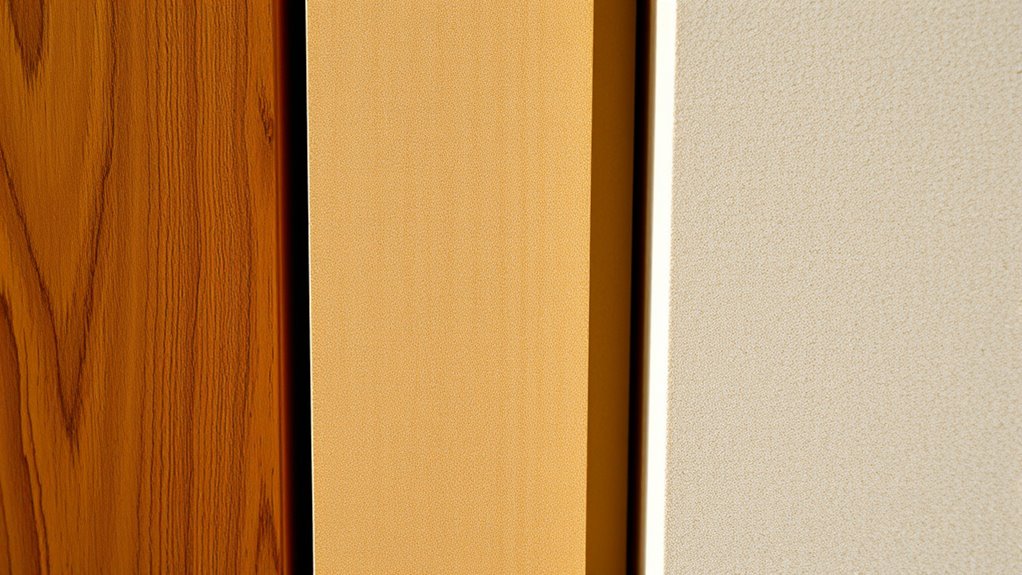
When comparing cabinetry materials, understanding their composition and construction is essential. Solid wood features natural grain patterns, offering unique aesthetics, but can be prone to expansion and contraction with moisture changes. Its moisture resistance depends on the type of wood and finish applied. Plywood is made of multiple layers of veneer glued together, creating a sturdy, stable core. Its layered construction reduces warping and enhances moisture resistance, making it suitable for humid environments. MDF, or medium-density fiberboard, is composed of compressed wood fibers bonded with resin. It has a smooth surface, but lacks the natural grain patterns of wood or plywood and is less moisture resistant unless properly sealed. Knowing these differences helps you choose the right material based on your needs for durability and moisture tolerance. Additionally, understanding how creative practice can foster innovative solutions may assist in selecting the most suitable cabinetry materials for your project.
Assessing the Aesthetic Appeal and Finish Options
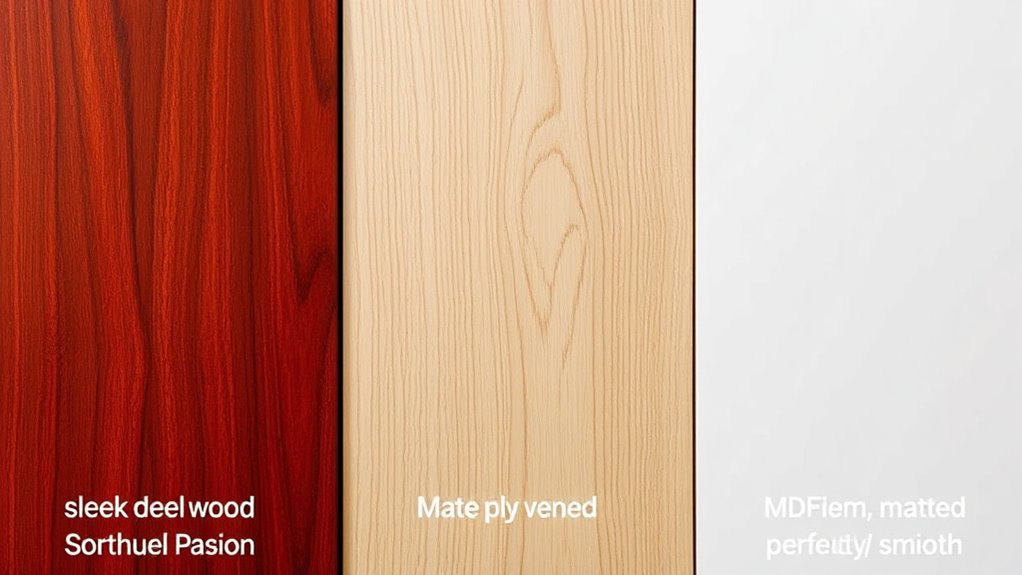
The aesthetic appeal of cabinetry materials largely depends on their finish options, which can dramatically alter their look and feel. Your choice of material influences grain patterns and stain compatibility, affecting overall style. Solid wood showcases distinct grain patterns that add character, while plywood offers a more uniform appearance. MDF provides a smooth surface ideal for painted finishes. Stain options highlight natural grain in solid wood and plywood, giving warmth and depth. MDF is best suited for painted finishes, offering a sleek, modern look. Here’s a quick comparison:
| Material | Grain Patterns | Stain Options |
|---|---|---|
| Solid Wood | Distinct, natural | Wide range, enhances grain |
| Plywood | Subtle, layered | Limited, depends on veneer |
| MDF | Minimal, smooth | Primarily painted |
Additionally, understanding the cabinetry material can help in selecting the most suitable option for your specific aesthetic and functional needs.
Evaluating Cost, Durability, and Maintenance Considerations

Choosing the right cabinetry material requires balancing cost, durability, and maintenance to guarantee long-term satisfaction. Your budget considerations will influence whether you choose affordable MDF, resilient plywood, or premium solid wood. Durability is key—solid wood offers lasting strength, but requires regular upkeep, while plywood balances cost and durability. MDF is low-cost but less resistant to moisture. Additionally, think about environmental impact—solid wood is renewable but may involve deforestation, whereas plywood and MDF often contain adhesives with volatile compounds. Considering the environmental impact of materials can help you make more eco-conscious choices that align with sustainable practices.
- Feel confident in a material that withstands daily use and looks great over time
- Minimize future repairs and replacements, saving money and effort
- Make environmentally conscious choices without sacrificing quality
Frequently Asked Questions
Which Material Is Most Environmentally Sustainable for Cabinetry?
When choosing cabinetry, you wonder which material is most eco-friendly. You should look for options with recycled content and sustainable sourcing. Plywood made from sustainably harvested wood or MDF with eco-friendly resins can diminish environmental impact. Solid wood from responsibly managed forests is also a good choice. By selecting eco-friendly options, you help protect the environment while enjoying durable, beautiful cabinets. Always check for certifications like FSC to ensure sustainability.
How Do Moisture Levels Affect Each Material’S Longevity?
Moisture levels considerably impact each material’s durability and moisture resistance. You’ll find solid wood susceptible to warping and cracking if exposed to high humidity, reducing its longevity. Plywood offers better moisture resistance and maintains its strength longer in damp environments, making it more durable. MDF, however, absorbs moisture easily, leading to swelling and compromised stability. Understanding these effects helps you choose the best material for your climate and ensures your cabinets last longer.
Can These Materials Be Customized With Different Paints or Stains?
Think of your cabinets as a blank canvas, ready for your artistic touch. You can definitely customize these materials with various paint options and stain versatility. Solid wood offers rich stains that highlight its natural beauty, while plywood and MDF accept paint beautifully for a sleek, modern look. So, whether you want vibrant colors or a warm, stained finish, each material can be tailored to match your style perfectly.
Are There Health Concerns Associated With Any of These Materials?
You might wonder if any cabinetry materials pose health risks. Solid wood generally has low VOC emissions, making it a healthier choice for indoor air quality. Plywood can emit VOCs from adhesives, especially if not formaldehyde-free, impacting air quality. MDF often contains higher formaldehyde levels, which can affect indoor air quality over time. To guarantee a healthier home, choose low-VOC options and ensure proper ventilation during installation.
Which Material Is Easiest to Repair or Refinish Over Time?
Imagine you spill wine on your cabinet door; solid wood is easiest to refinish, making it ideal for repairability considerations. You can sand and re-stain it, restoring its beauty. Plywood and MDF are more challenging to refinish—MDF, especially, tends to swell if moisture gets in. For long-term ease of repair and refinishing potential, solid wood typically wins, allowing you to maintain your cabinets with less hassle over time.
Conclusion
Choosing the right cabinetry material is like selecting the perfect brushstroke for your masterpiece—each option brings its own character and charm. Solid wood offers timeless beauty, plywood balances strength and affordability, while MDF provides a smooth, versatile finish. Consider your style, budget, and maintenance needs carefully. Ultimately, the best choice aligns with your vision, turning your space into a work of art. After all, your cabinets are the foundation of your home’s story—make them unforgettable.


